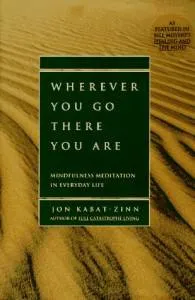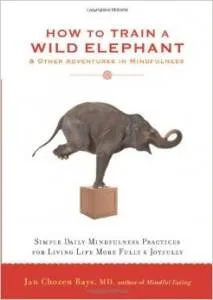
9 Books for Those Looking to Master Mindfulness and Perhaps Ascend to a Higher Plane
This content contains affiliate links. When you buy through these links, we may earn an affiliate commission.
Many of my students are intimidated by the prospect of taking up a meditation practice. They imagine that those proficient at meditation wear flowing white garments, sit easily in full lotus, and are able to levitate a full foot above their meditation cushion, their minds a radiant blank.
In actuality, meditation can be a daily struggle, one that comes with ease on one day, but that makes your head want to explode the next. Which is why I find it so helpful to read about the practice. The right books can dispel myths, prepare you for what to expect from a mindfulness practice, and also make the practice itself more accessible.
And while you may not achieve enlightenment (watch me get stuck behind a slow driver and you’ll know I’m far from it), mindfulness can help you respond to the twists and turns of life in a healthier, more balanced manner.
Where should you start?
Thich Nhat Hanh’s You Are Here. This book is a classic of the genre, and often appears on the reading lists of teaching certification programs. Written by a renowned Zen monk and meditation master, it teaches readers about the benefits mindfulness can have in their lives.
Sharon Salzberg’s Real Happiness. Salzberg is known for her book on lovingkindness meditation. Her followup provides readers with a 28-day program for developing a meditation practice, with a section specifically on mindfulness. It’s an easy intro to the practice for meditation noobs.
 Jon Kabat -Zinn’s Wherever You Go, There You Are. Another classic by a well-known meditation teacher, this bestseller delves into the importance of meditation as a path toward mindfulness.
Susan L. Smalley, Ph.D. and Diana Winston’s Fully Present. Let’s put aside the classics for the moment. If this is all sounding a bit too woo-woo for you, check out this book on the science behind mindfulness, and how it can positively affect the brain and the body. In addition to research, this book provides ways in which you can bring mindfulness into your daily life outside of traditional meditation.
Chade-Meng Tan’s Search Inside Yourself. Another more contemporary read, this book was actually written by the Google employee in charge of teaching his colleagues how to employ mindfulness techniques during their work days. If your work is your life (as mine is), you may want to pick this one up.
Jon Kabat -Zinn’s Wherever You Go, There You Are. Another classic by a well-known meditation teacher, this bestseller delves into the importance of meditation as a path toward mindfulness.
Susan L. Smalley, Ph.D. and Diana Winston’s Fully Present. Let’s put aside the classics for the moment. If this is all sounding a bit too woo-woo for you, check out this book on the science behind mindfulness, and how it can positively affect the brain and the body. In addition to research, this book provides ways in which you can bring mindfulness into your daily life outside of traditional meditation.
Chade-Meng Tan’s Search Inside Yourself. Another more contemporary read, this book was actually written by the Google employee in charge of teaching his colleagues how to employ mindfulness techniques during their work days. If your work is your life (as mine is), you may want to pick this one up.
 Jan Chozen Bays’s How to Train a Wild Elephant. This one was actually recommended to me by the meditation teacher who stepped in to teach me and my fellow yoga teacher trainees various meditation techniques during our certification program. Bays—a physician and Zen teacher—shares a series of mindfulness exercises that are easy to slip into the stream of your day to day.
Pema Chödrön’s How to Meditate. This American-born Tibetan-Buddhist nun is known for her quietly brilliant words of wisdom on peace, compassion, connection, and life in general. In How to Meditate, she dives deep into the essential steps one must take to live a life that’s firmly rooted in the present.
Bhante Henepola Gunaratana’s Mindfulness in Plain English English. This Sri Lankan Theravada Buddhist monk has published many books on mindfulness, but this is his most popular. It is considered one of the most influential books in the growing field of mindfulness, and acts as a great introduction to mindfulness meditation.
Davidji’s Secrets of Meditation. This is my favorite book on mindfulness meditation, and the one I turn to again and again when I’m putting together my own meditation workshops. It contains in-depth sections on many different types of meditation, plus an FAQ section that really gives readers insight into what they can expect from mindfulness meditation… and what they shouldn’t.
Jan Chozen Bays’s How to Train a Wild Elephant. This one was actually recommended to me by the meditation teacher who stepped in to teach me and my fellow yoga teacher trainees various meditation techniques during our certification program. Bays—a physician and Zen teacher—shares a series of mindfulness exercises that are easy to slip into the stream of your day to day.
Pema Chödrön’s How to Meditate. This American-born Tibetan-Buddhist nun is known for her quietly brilliant words of wisdom on peace, compassion, connection, and life in general. In How to Meditate, she dives deep into the essential steps one must take to live a life that’s firmly rooted in the present.
Bhante Henepola Gunaratana’s Mindfulness in Plain English English. This Sri Lankan Theravada Buddhist monk has published many books on mindfulness, but this is his most popular. It is considered one of the most influential books in the growing field of mindfulness, and acts as a great introduction to mindfulness meditation.
Davidji’s Secrets of Meditation. This is my favorite book on mindfulness meditation, and the one I turn to again and again when I’m putting together my own meditation workshops. It contains in-depth sections on many different types of meditation, plus an FAQ section that really gives readers insight into what they can expect from mindfulness meditation… and what they shouldn’t.
 Bonus recommendation: Adult coloring books. I know, you guys. So played out. But I went to one of those paint and sip classes and we painted our own mandalas and it was so relaxing. I immediately purchased a mandala coloring book and I love it. The thing with many adult coloring books (at least for me) is that it’s easy to get overwhelmed by all the different ways you can start. But with mandalas, you’re supposed to start from the center and work your way out. So you don’t have to think about a damn thing. You just have to focus. On one spot. And then the next one. And the next. Next stop: samadhi.
Bonus recommendation: Adult coloring books. I know, you guys. So played out. But I went to one of those paint and sip classes and we painted our own mandalas and it was so relaxing. I immediately purchased a mandala coloring book and I love it. The thing with many adult coloring books (at least for me) is that it’s easy to get overwhelmed by all the different ways you can start. But with mandalas, you’re supposed to start from the center and work your way out. So you don’t have to think about a damn thing. You just have to focus. On one spot. And then the next one. And the next. Next stop: samadhi.
 Jon Kabat -Zinn’s Wherever You Go, There You Are. Another classic by a well-known meditation teacher, this bestseller delves into the importance of meditation as a path toward mindfulness.
Susan L. Smalley, Ph.D. and Diana Winston’s Fully Present. Let’s put aside the classics for the moment. If this is all sounding a bit too woo-woo for you, check out this book on the science behind mindfulness, and how it can positively affect the brain and the body. In addition to research, this book provides ways in which you can bring mindfulness into your daily life outside of traditional meditation.
Chade-Meng Tan’s Search Inside Yourself. Another more contemporary read, this book was actually written by the Google employee in charge of teaching his colleagues how to employ mindfulness techniques during their work days. If your work is your life (as mine is), you may want to pick this one up.
Jon Kabat -Zinn’s Wherever You Go, There You Are. Another classic by a well-known meditation teacher, this bestseller delves into the importance of meditation as a path toward mindfulness.
Susan L. Smalley, Ph.D. and Diana Winston’s Fully Present. Let’s put aside the classics for the moment. If this is all sounding a bit too woo-woo for you, check out this book on the science behind mindfulness, and how it can positively affect the brain and the body. In addition to research, this book provides ways in which you can bring mindfulness into your daily life outside of traditional meditation.
Chade-Meng Tan’s Search Inside Yourself. Another more contemporary read, this book was actually written by the Google employee in charge of teaching his colleagues how to employ mindfulness techniques during their work days. If your work is your life (as mine is), you may want to pick this one up.
 Jan Chozen Bays’s How to Train a Wild Elephant. This one was actually recommended to me by the meditation teacher who stepped in to teach me and my fellow yoga teacher trainees various meditation techniques during our certification program. Bays—a physician and Zen teacher—shares a series of mindfulness exercises that are easy to slip into the stream of your day to day.
Pema Chödrön’s How to Meditate. This American-born Tibetan-Buddhist nun is known for her quietly brilliant words of wisdom on peace, compassion, connection, and life in general. In How to Meditate, she dives deep into the essential steps one must take to live a life that’s firmly rooted in the present.
Bhante Henepola Gunaratana’s Mindfulness in Plain English English. This Sri Lankan Theravada Buddhist monk has published many books on mindfulness, but this is his most popular. It is considered one of the most influential books in the growing field of mindfulness, and acts as a great introduction to mindfulness meditation.
Davidji’s Secrets of Meditation. This is my favorite book on mindfulness meditation, and the one I turn to again and again when I’m putting together my own meditation workshops. It contains in-depth sections on many different types of meditation, plus an FAQ section that really gives readers insight into what they can expect from mindfulness meditation… and what they shouldn’t.
Jan Chozen Bays’s How to Train a Wild Elephant. This one was actually recommended to me by the meditation teacher who stepped in to teach me and my fellow yoga teacher trainees various meditation techniques during our certification program. Bays—a physician and Zen teacher—shares a series of mindfulness exercises that are easy to slip into the stream of your day to day.
Pema Chödrön’s How to Meditate. This American-born Tibetan-Buddhist nun is known for her quietly brilliant words of wisdom on peace, compassion, connection, and life in general. In How to Meditate, she dives deep into the essential steps one must take to live a life that’s firmly rooted in the present.
Bhante Henepola Gunaratana’s Mindfulness in Plain English English. This Sri Lankan Theravada Buddhist monk has published many books on mindfulness, but this is his most popular. It is considered one of the most influential books in the growing field of mindfulness, and acts as a great introduction to mindfulness meditation.
Davidji’s Secrets of Meditation. This is my favorite book on mindfulness meditation, and the one I turn to again and again when I’m putting together my own meditation workshops. It contains in-depth sections on many different types of meditation, plus an FAQ section that really gives readers insight into what they can expect from mindfulness meditation… and what they shouldn’t.
 Bonus recommendation: Adult coloring books. I know, you guys. So played out. But I went to one of those paint and sip classes and we painted our own mandalas and it was so relaxing. I immediately purchased a mandala coloring book and I love it. The thing with many adult coloring books (at least for me) is that it’s easy to get overwhelmed by all the different ways you can start. But with mandalas, you’re supposed to start from the center and work your way out. So you don’t have to think about a damn thing. You just have to focus. On one spot. And then the next one. And the next. Next stop: samadhi.
Bonus recommendation: Adult coloring books. I know, you guys. So played out. But I went to one of those paint and sip classes and we painted our own mandalas and it was so relaxing. I immediately purchased a mandala coloring book and I love it. The thing with many adult coloring books (at least for me) is that it’s easy to get overwhelmed by all the different ways you can start. But with mandalas, you’re supposed to start from the center and work your way out. So you don’t have to think about a damn thing. You just have to focus. On one spot. And then the next one. And the next. Next stop: samadhi.








